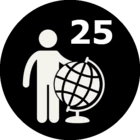I work on Internet of Things projects. We have lots of sensors that provide data that needs to be timestamped with milisecond accuracy so that we can see which combination of sensors recognize events and objects. I want to do correlation between data at a milisecond accurracy.
The issue is that I cannot directly convert the time information (milliseconds from epoc) to date with the DateFormatter, since the %s directive only takes integer values;
http://docs.safe.com/fme/html/FME_Transformers/FME_Transformers.htm#Transformers/dateformatter.htm









